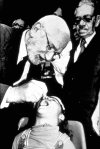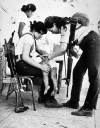Albert Sabin and the Coalition to Eliminate Polio from the Americas
- PMID: 19008524
- PMCID: PMC2636601
- DOI: 10.2105/AJPH.2007.117952
Albert Sabin and the Coalition to Eliminate Polio from the Americas
Abstract
Albert B. Sabin, MD, developer of the oral polio vaccine, was also a major proponent of its use in annual vaccination campaigns aimed at the elimination of polio. Sabin argued that administering his vaccine simultaneously to every child in a country would break polio's chains of transmission. Although he was already promoting mass vaccination by the 1960s, Sabin's efforts expanded considerably when he became an adviser to groups fighting polio in the Americas in the 1980s. Sabin's experiences provide a window into both the formation of the coalition that eliminated poliomyelitis from the Western Hemisphere and what can happen when biomedical researchers become public health policy advisers. Although the polio elimination coalition succeeded in part because member groups often accommodated each other's priorities, Sabin was often limited by his indifference to the interests of those he was advising and to the shortcomings of his vaccine.
Figures




Similar articles
-
[The battle in Madrid over poliomyelitis vaccines (1963): science, ideology and power in the first mass immunization campaign in Spain].Gac Sanit. 2019 Sep-Oct;33(5):480-484. doi: 10.1016/j.gaceta.2018.05.005. Epub 2018 Jul 19. Gac Sanit. 2019. PMID: 30031656 Spanish.
-
The history of polio vaccination with "Sabin's OPV" 60 years after its introduction in Italy: an unforgivable "delay".J Prev Med Hyg. 2024 Mar 31;65(1):E105-E112. doi: 10.15167/2421-4248/jpmh2024.65.1.3242. eCollection 2024 Mar. J Prev Med Hyg. 2024. PMID: 38706758 Free PMC article.
-
[Gestation and conduct of the First National Campaign of oral polio vaccination in Spain].Rev Esp Salud Publica. 2013 Sep-Oct;87(5):455-60. doi: 10.4321/S1135-57272013000500004. Rev Esp Salud Publica. 2013. PMID: 24322282 Spanish.
-
Pioneering figures in medicine: Albert Bruce Sabin--inventor of the oral polio vaccine.Kurume Med J. 2005;52(3):111-6. doi: 10.2739/kurumemedj.52.111. Kurume Med J. 2005. PMID: 16422178 Review.
-
Sabin monovalent oral polio vaccines: review of past experiences and their potential use after polio eradication.Clin Infect Dis. 2001 Aug 15;33(4):531-41. doi: 10.1086/321905. Epub 2001 Jul 9. Clin Infect Dis. 2001. PMID: 11462191 Review.
Cited by
-
The impact of polio eradication on routine immunization and primary health care: a mixed-methods study.J Infect Dis. 2014 Nov 1;210 Suppl 1(Suppl 1):S504-13. doi: 10.1093/infdis/jit232. Epub 2014 Apr 1. J Infect Dis. 2014. PMID: 24690667 Free PMC article.
-
From legacy to integration in the Global Polio Eradication Initiative: looking back to look forward.BMJ Glob Health. 2024 May 8;9(5):e014758. doi: 10.1136/bmjgh-2023-014758. BMJ Glob Health. 2024. PMID: 38770815 Free PMC article.
-
Per Diems in Polio Eradication: Perspectives From Community Health Workers and Officials.Am J Public Health. 2017 Sep;107(9):1470-1476. doi: 10.2105/AJPH.2017.303886. Epub 2017 Jul 20. Am J Public Health. 2017. PMID: 28727538 Free PMC article.
-
The path towards polio eradication over 40 years of the Expanded Program on Immunization in the Americas.Rev Panam Salud Publica. 2017 Dec 20;41:e154. doi: 10.26633/RPSP.2017.154. eCollection 2017. Rev Panam Salud Publica. 2017. PMID: 31391837 Free PMC article.
-
A Possible Path towards Rapid Development of Live-Attenuated SARS-CoV-2 Vaccines: Plunging into the Natural Pool.Biomolecules. 2020 Oct 14;10(10):1438. doi: 10.3390/biom10101438. Biomolecules. 2020. PMID: 33066343 Free PMC article.
References
-
- Albert B. Sabin to Alcir Chacar, January 17, 1980, box 7, Polio, International Cooperation, Brazil, 1955–1980, A-C; file Brazil, 1980, Jan–Feb. Correspondence, Hauck Center for the Albert B. Sabin Archives, University of Cincinnati, OH (hereafter cited as Sabin Archives).
-
- David M.
-
- Walter R. Dowdle and Stephen L. Cochi, “Global Eradication of Poliovirus: History and Rationale,” in Molecular Biology of Picornaviruses, ed. Bert L. Semler and Eckard Wimmer, 473–80 (Washington, DC: ASM Press, 2002); Ciro A. de Quadros, “Onward Towards Victory,” in Polio (see note 2), 181–98; R. Bruce Aylward, Arnab Acharya, Sarah England, Mary Agocs, and Jennifer Linkins, “Global Health Goals: Lessons from the World Wide Effort to Eradicate Poliomyelitis,” Lancet 362 (2003), 909–14; Ruth Levine, “Eliminating Polio in Latin America and the Caribbean,” in Millions Saved: Proven Successes in Global Health, ed. Ruth Levine and the What Works Working Group, 39–46 (Washington, DC: Center for Global Development, 2004); Bernard Seytre and Mary Shaffer, The Death of a Disease: A History of the Eradication of Poliomyelitis, trans. Mary Shaffer (New Brunswick, NJ: Rutgers University Press, 2005); Marcos Cueto, The Value of Health: A History of the Pan American Health Organization (Washington DC: PAHO, 2006)
-
- Oshinsky, Polio, 137–275.
-
- Albert B. Sabin, Manuel Ramos-Alvarez, Jose Alvarez-Amezquita, William Pelon, Richard H. Michaels, Ilya Spigland, Meinrad A. Koch, Joan M. Barnes, and Johng S. Rhim, “Live, Orally Given Poliovirus Vaccine: Effects of Rapid Mass Immunization on Population under Conditions of Massive Enteric Infection with Other Viruses,” Journal of the American Medical Association 173, no. 14 (1960), 1521–26; Albert B. Sabin, Richard H. Michaels, Ilya Spigland, William Pelon, Johng S. Rhim, and Eugene R. Wehr, “Community-Wide Use of Oral Poliovirus Vaccine-Effectiveness of the Cincinnati Program,” American Journal of Diseases of Children 101 (1961), 546–67
Publication types
MeSH terms
Substances
Personal name as subject
- Actions
LinkOut - more resources
Full Text Sources
Medical

